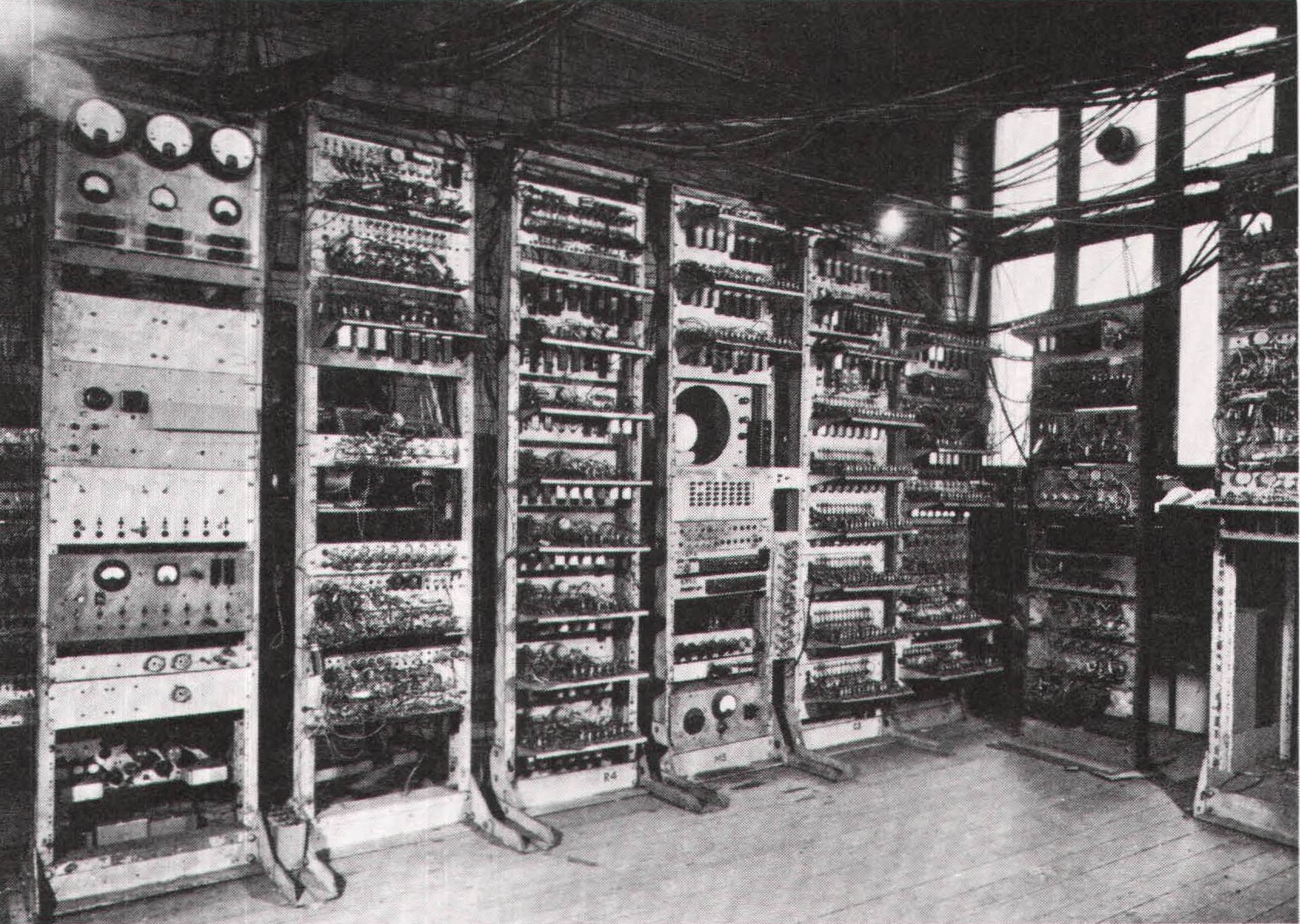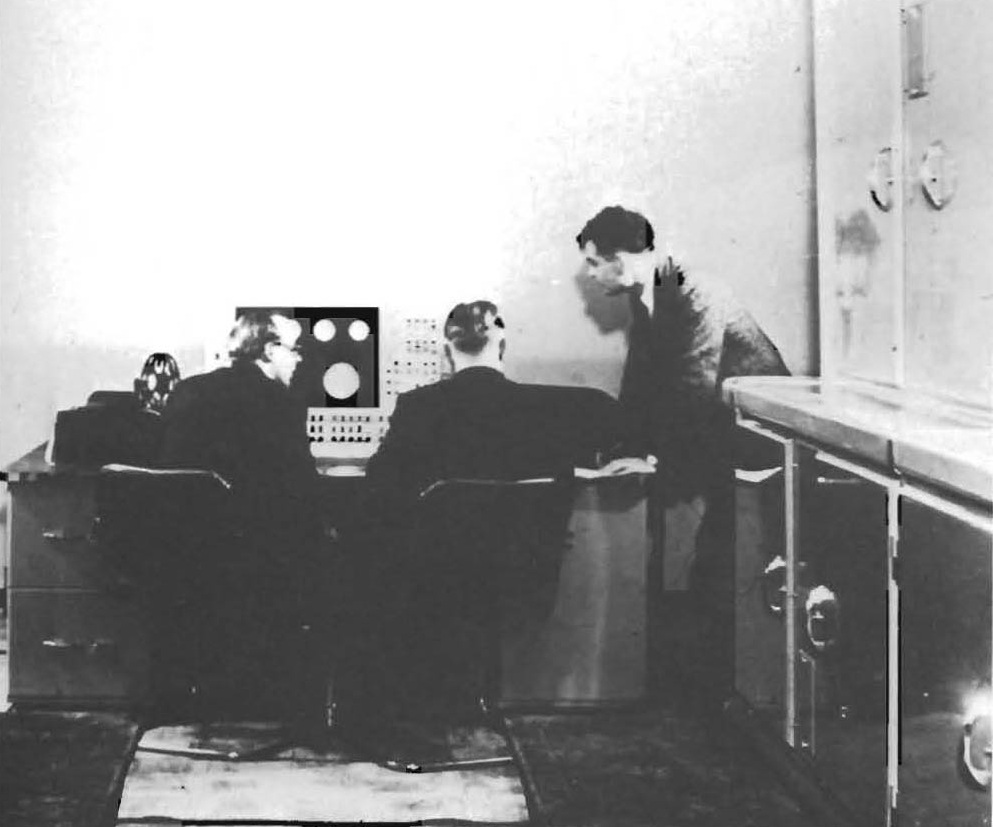The first scientist on Womersley’s staff was, fittingly enough, Turing. Charged with the task of developing the machine, Turing studied von Neumann’s paper and then wrote one of his own, a comprehensive plan for a large computer called ACE, or Automatic Computing Engine. (The “engine” in the name was a bow to Babbage.) ACE was an ambitious machine, with a memory of 204,800 bits and an operating speed of a million pulses a second – ten times faster than ENIAC. Turing devoted a lot of attention to ACE’s programming, drawing up a roster of programs, composed in a partially numerical, partially alphabetical code, which were the first bona fide programs. But ACE became a victim of bureaucratic indecision and miscomprehension, and a drastically scaled down version, the Pilot ACE, was constructed instead. This machine was completed in May 1950, but by that time Turing, fed up by the timidity and indecision of the National Physical Laboratory, had escaped to Manchester University, where a more efficient computer project was underway.
The Manchester endeavor had been set up by Max Newman, a professor of mathematics, in mid-1946 with a large grant from the Royal Society. One of Britain’s leading mathematicians, Newman was as cognizant of the possibilities of electronic computation as Turing. At Cambridge, where he had taught before the war, Newman had read “Computable Numbers” in typescript; in fact, he had been the paper’s first reader. And at Bletchley Park, where most of the country’s best mathematicians spent the war, Newman had been one of the originators of Colossus. He and his Manchester associates were in a perfect position to develop a computer, and they managed to build a working prototype by June 1948 (before Turing came on board). Known as the Manchester Mark I, it was the first fully electronic stored-program computer in operation.
The invention of an efficient and reliable form of internal memory was the most difficult task facing the Mark I’s designers. There were several promising techniques, but the best was developed by F. C. Williams, the project’s chief engineer. He hit upon the idea of employing ordinary cathode ray tubes (CRTs) – the same large, bottle-shaped tubes that were used in radar to display data and in TV sets to show the picture. Their operating principle was quite simple; “guns” in the bases of the tubes shot positively and negatively charged electrons at the faces of the tubes, thus storing bits in the form of charge spots, which, by the way, were quite visible to the eye. Since CRTs didn’t have to be specially made, they were inexpensive. They were also small and fast and could retain a fair amount of data – 1,024 or 2,048 bits. Unfortunately, they were rather fickle, occasionally dropping a bit here and there, but they became the most prevalent internal-storage medium.

The first stored program on an electronic computer, a search for the factors of a number, ran on the Mark I on 21 June 1948. (A factor is a number that, multiplied by other numbers, yields a given product; for example, the factors of 45 are 5, 3, and 3.) The program was loaded into the machine, a jumble of racks, wires, and tubes, with three CRTs glowing in a gloomy room. As Williams described the great moment:
When [the machine was] first built, a program was laboriously inserted and the start switch pressed. Immediately the spots on the display tube entered a mad dance. In early trials it was a dance of death leading to no useful result, and what was even worse, without yielding any clue as to what was wrong. But one day it stopped and there, shining brightly in the expected place, was the expected answer.


Pleased by the success of the Mark I prototype, the British government, which wanted a computer for its own atomic bomb project, among other things, commissioned Ferranti Ltd., a weapons and electronics manufacturer in Manchester, to construct a computer based on the machine. Ferranti started work in 1949 and the first commercial computer, the Ferranti Mark I, was installed in Manchester’s new computing center in February 1951. Aided by the British government, Ferranti went into the computer business and sold eight Mark I’s in a few years. The University of Toronto, which wanted a machine to help with the design of the St. Lawrence Seaway, was Ferranti’s first customer, and several Mark I’s went to the British Atomic Weapons Research Establishment and to other government agencies. Soon other firms got into the act; for example, the English Electric Company built a very successful computer based on the Pilot ACE.

The third British computer of the postwar era was built at Cambridge. Known as EDSAC, for Electronic Delay Storage Automatic Computer, it was completed in June 1949 and was the first stored-program computer with any serious computational ability. (The Mark I was a prototype.) EDSAC was based unabashedly on EDVAC, and in both cases internal storage was provided by a gadget known as a mercury delay line, an idea of Eckert’s. Essentially, a delay line is a thin tube, filled with mercury, that stores electronic pulses, or bits, in much the same fashion as a canyon holds an echo; generated by crystals in the tube, the pulses bounce back and forth, periodically re-energized by electronic components attached to the tube. The computer can call up the pulses at any time. Compared to CRTs, delay lines were slower, much larger, more expensive, and harder to make, but they were very reliable and could hold much more information. Delay lines were widely used until the early 1950s, when they, and CRTs, were replaced by an eminently practical form of storage known as magnetic cores.